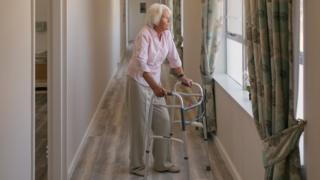 Image copyright
Getty Images
Image copyright
Getty Images
New guidance will bring cautious optimism for families who want to see relatives who are living in care homes in England.
So what are the new rules?
Can I visit family in a care home?
You have to check with the care home before you plan a visit.
The guidance, published on 22 July, is not a blanket rule change across England.
It is ultimately up to care homes, local authorities and their public health experts, to decide whether it is safe to open to visitors.
The government says a localised approach means they can respond quickly to any spikes in cases in an area, and assess specific risks to certain homes.
Can all the family visit?
If the care home allows visits, the guidance recommends it "should be limited to a single constant visitor, per resident, wherever possible."
So, if your mother is in a care home, just one of her children should be allowed to visit. If there is a visit a week later, it should be the same child.
The guidance says this will limit the number of different people visiting the care home.
Can I hug my relative?
"Visitors should be encouraged to keep personal interaction with the resident to a minimum, for example avoid skin-to-skin contact (handshake, hug)," the guidance says.
They should also "follow the latest social-distancing advice for as much of the visit as possible."
Currently, people are advised to stay "one metre plus" from one another.
What do I need to know about the coronavirus?
Can we leave the care home?
The guidance doesn't mention leaving the care home, to go out for lunch for example.
It does recommend that visits take place in care home gardens.
Professor Martin Green, chief executive of care home body Care England, has criticised this lack of clarity.
"As lockdown lifts we are likely to see many care providers and relatives wanting to take their loved one out for visits.
"The failure to acknowledge this nuance underscores the lack of governmental understanding of the complexities present within the adult social care sector."
Do I need to wear a face covering?
Visitors are being asked to wear face coverings, but may have to wear more personal protective equipment - such as a visor or gloves - if the resident is particularly cautious.
The guidance recognises that in very exceptional circumstances, such as for residents with dementia, some visitors might not be recognised with face coverings. It says that alternatives, such as clear visors, can be used as an exception to the rule.
Visitors should speak loudly, not wear hats and keep eye contact to help residents recognise them.
If possible, care homes should prepare residents for a visit by showing them photographs or reminding them of stories related to the visitor.
What other precautions should I take?
The guidance says you should also:
- Drive to the home if possible
- Wash your hands regularly
- Stay away if you have shown symptoms in the past week
- Think about whether to bring gifts, because they might need to be decontaminated
They also say that, even where in-person visits are permitted, alternatives should be thought of first, such as the use of telephone or video.
What should care homes do?
Different care homes will operate different systems, so it is worth getting in touch if you have any questions.
The guidance asks care homes to explore:
- Whether they will have a booking system, to minimise the number of visitors at one time
- Whether visits should take place in gardens or specialised rooms
- Whether screens can be put up between visitors and residents
They will also keep up infection control procedures, such as regular cleaning and hand-washing.
What about the rest of the UK?
In Scotland, care homes can receive one designated visitor if the home has been free from coronavirus for 28 days. Currently, the visits must be outdoors.
In Wales, guidance is in place to facilitate outdoor visits to care homes.
In Northern Ireland, one person can visit a care home resident, with a second person accommodated "where possible". Visitors must wear face masks and day-to-day decisions will be made by care home managers.